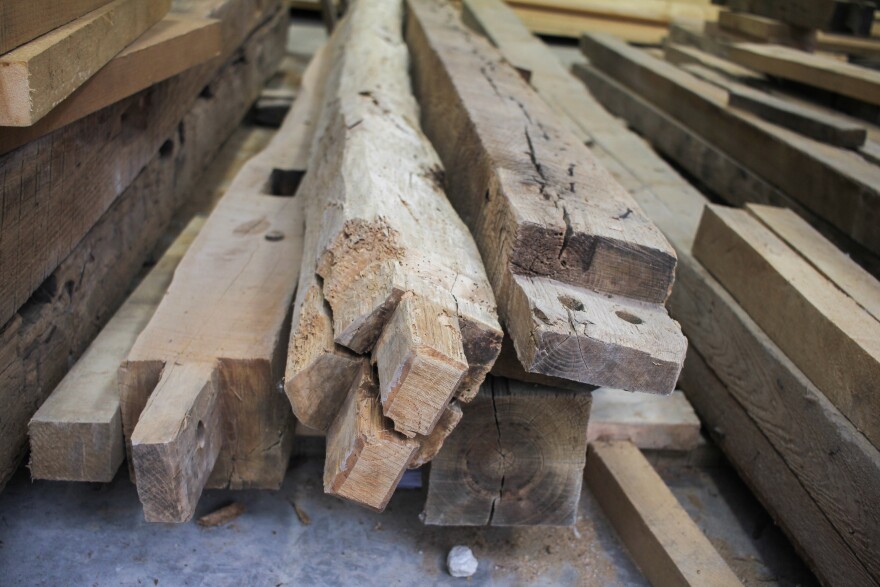Debbie Ledley’s family bought a farm near the Delaware County Airport in 1968, when she was just 4 years old. The farm included a big, old barn.
Her father boarded horses and was a grain farmer, Ledley said.
“So, there were gravity (grain) wagons in there. And then we would climb up the hay mow and swing from one side to the other right over the gravity wagon,” Ledley recalled.
Now, with Ledley’s parents in their 80s and no one to take over the farm, it was time for it to go, she said. A company purchased the land last summer to build warehouses.
Ledley's voice cracked as she explained, “Mom and dad sold the farm, and it was just going to be destroyed.”

It’s a story you hear more and more – farms and their barns lose their usefulness, and the land is redeveloped.
But the nonprofit Friends of Ohio Barns believes there’s value in saving the state's historic barns.
The group’s vice president, Dan Troth, is helping Debbie Ledley and her husband, Chris, do just that. They are moving and rebuilding the late-1800s barn to serve as their home outside of Ostrander – between Marysville and Delaware. Troth, a contractor, is overseeing the reconstruction.
Declining number of barns
Historic barns are coming down all over the state, Troth said. Often, they are dismantled for their timber.
“I've talked to people, where's this stuff going? And they said, well, it's all going out of state, going to Texas, the Carolinas, Florida, Montana, Colorado, California – everywhere that they don't have barns,” he said.
For those who sell the wood, it’s like elephant tusks, Troth said.
“But our group, Friends of Ohio Barns, we're trying to save the elephants,” he said.

Friends of Ohio Barns encourages preservation by working with the National Barn Alliance, other state-wide barn organizations and the Ohio Historical Society to connect barn owners with repair specialists.
The group also holds an annual barn conference in the spring and recognizes agricultural use, adaptive reuse, and stewardship with its Barn of the Year Awards.
Troth doesn’t entirely fault people for selling barns in bits and pieces – it saves the timber, after all, and is better than burning, which is now illegal. Troth, however, believes Ohio’s historic barns belong in Ohio.
“The bottom line is this – these barns represent Ohio's story. This is our story,” he said.
Troth also lives in a relocated and refurbished early-1800s barn. He noted that when barns are saved, they are usually moved. They become brewpubs, community centers and event venues – and houses, like his and the Ledleys’.
Rich agricultural history
Ohio's Farmland Preservation Office lists about two thousand historic family farms. The oldest in Adams County dates to 1772.
But those farm owners don't have to tell the office when they sell their land, said Jessi Starkey with the Ohio Department of Agriculture. Plus, the Historic Family Farm Program does not recognize historic structures, but the land itself and the families that farmed it – meaning historic farms don’t necessarily have original barns.

Troth noted that at one point almost all of Ohio’s residents were either farmers or farming-adjacent. He estimates that in the 1850s, ‘60s, and ‘70s, there were a few hundred thousand farms.
“And every one of them had a barn,” Troth said.
Ohio has found a way to recognize barns: they became an official state symbol in 2019, thanks to the efforts of a group of Westerville City Schools students, and a little help from Troth’s organization.
Legacy
Troth keeps an extensive collection of barn-raising photos. He said they used to be community events.
“Turning these barns, knowing the history that's in them, into public places, public venues, no matter what it is, it kind of brings that sense of community back,” he said.
As for Debbie Ledley, her new house will always be connected to old memories.
“So, every time you walk in through the door, you just remember the blizzard of ‘78, what dad was doing, you know, in the barn, pulling in tractors out to plow out the neighbors who were burning their furniture to stay warm,” she said.

As of 2022, the U.S. Department of Agriculture listed more than 76,000 farms in Ohio. Agriculture is the state’s biggest industry, generating around $124 billion annually, Starkey said.
But, as tech and manufacturing continue to expand in rural parts of the state, Troth wants to pay tribute to the history of that land.
“And they're moving us into the future with technology. But I just think, how can we pay tribute to the farmers whose land we've bought? And I'm thinking, boy, it's a great place for a barn where the community can gather,” Troth said.

